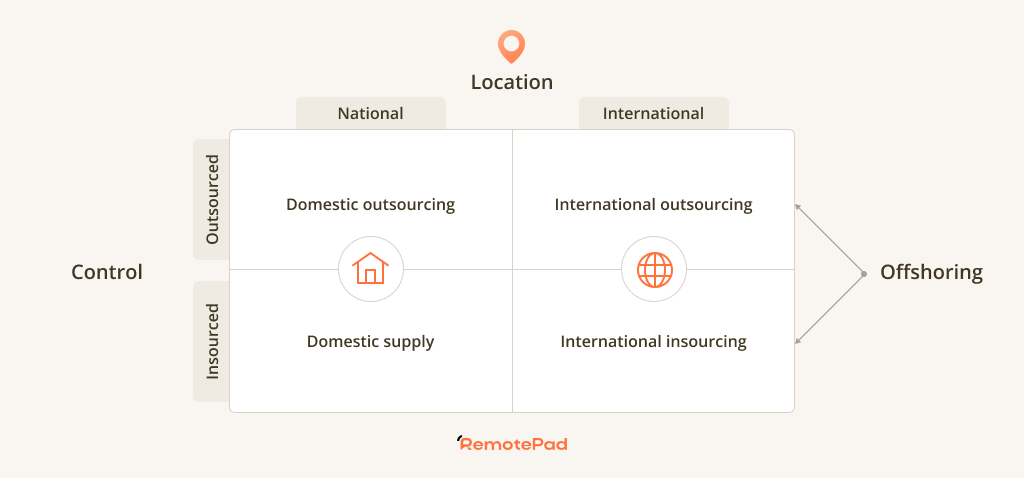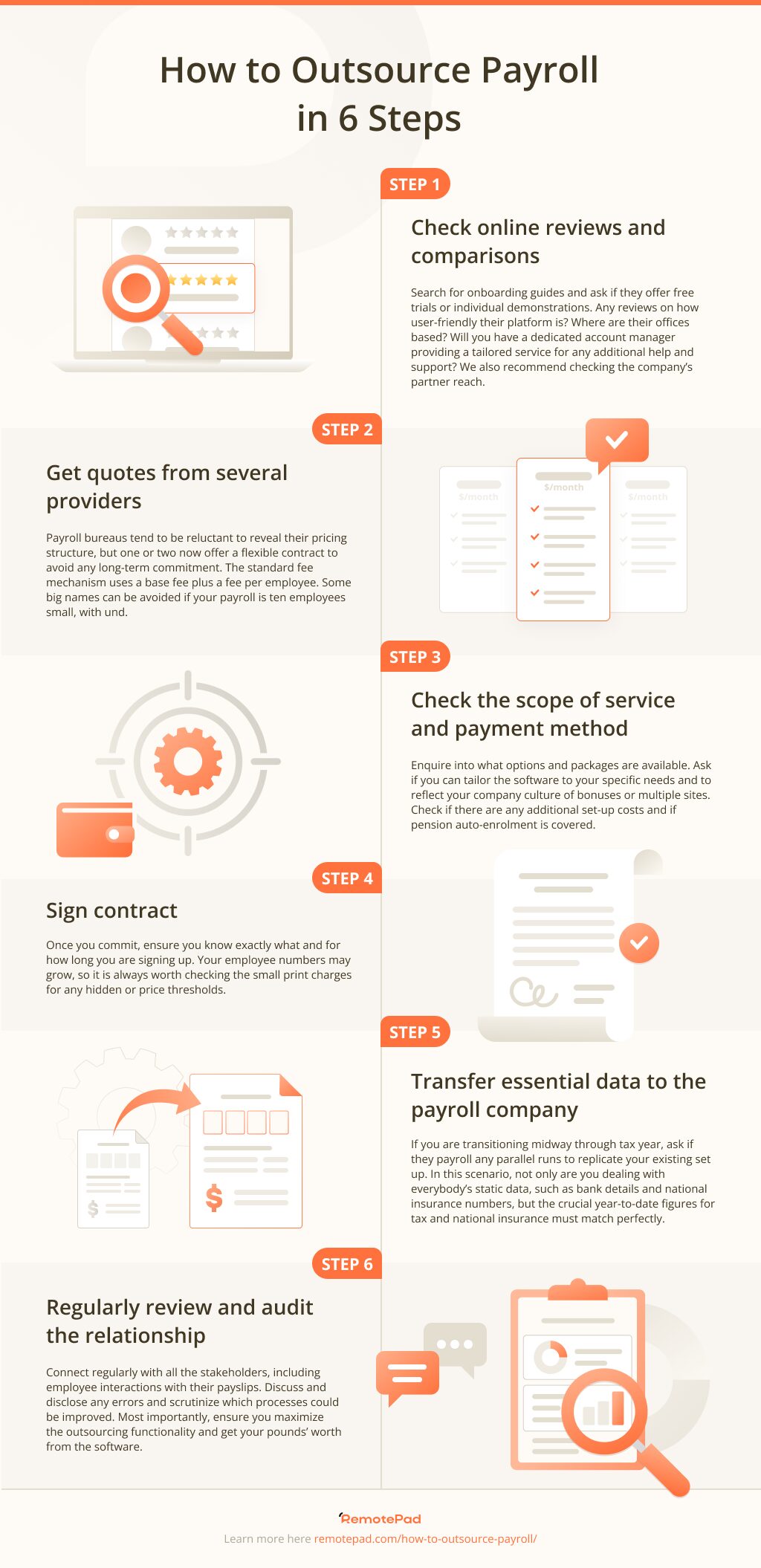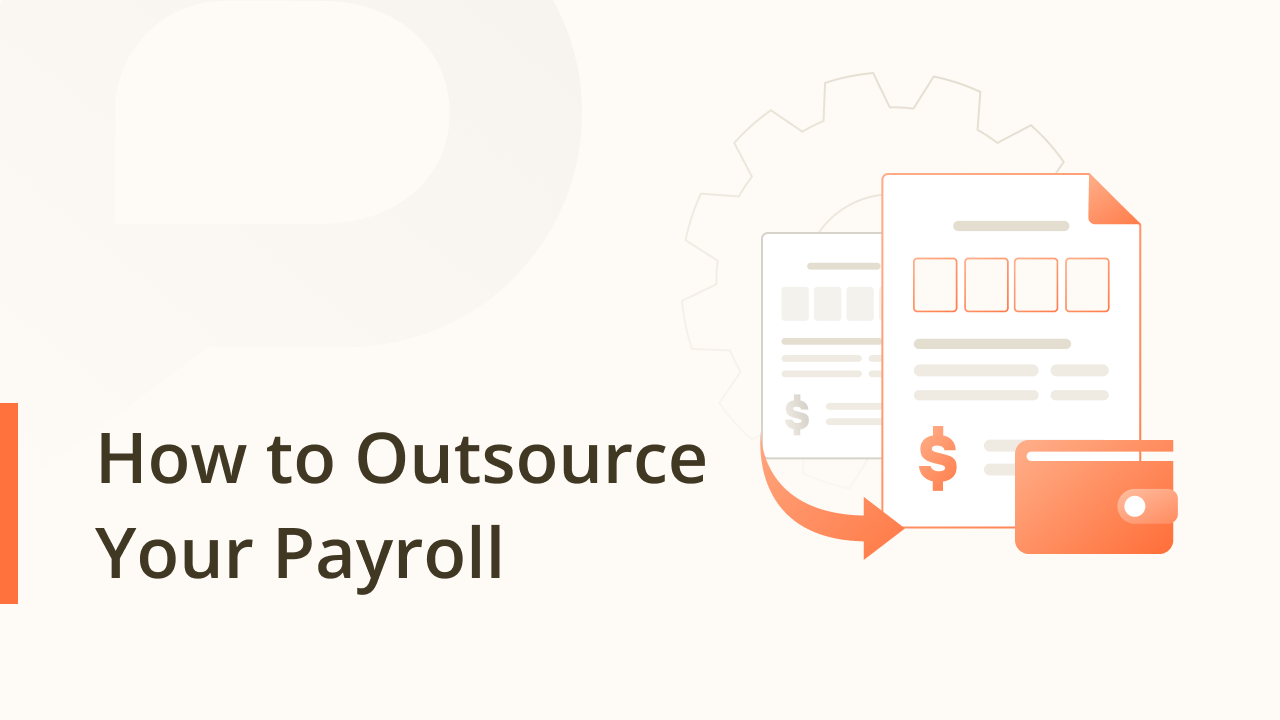Table of Contents
showSpending too much on recruitment, payroll or global HR?
We help you find the Best Providers at the lowest cost.
Companies considering how to outsource payroll have a lot to gain. Payroll outsourcing offers benefits such as saving time, minimizing errors on payroll taxes, enhancing data security, ensuring compliance with regulations, accessing expert knowledge of government regulations, reducing non-compliance risk, and enjoying considerable cost savings.
Key Takeaways
- The advantages of payroll outsourcing services mean that many businesses are considering outsourcing part of, or their entire, payroll process.
- When outsourcing payroll, you must consider which element or block you wish to outsource.
- If you outsource payroll, it is essential to think about online provider reviews, the scope of service, contracts, data transfer, and the regular review or audit of the relationship.
Often, it pays to think about payroll: From the new start-up to the well-established national brand, pondering payroll is a profitable game.
Most businesses outsource at least one process, and 60% admit they don’t want to handle their payroll. This market is slick, secure, and sophisticated. It also improves daily, using artificial intelligence (AI) to handle repetitive tasks. A Google search will flood your screen with many providers, so you must understand payroll first and outsource second.
Only when things go wrong are the risks and processes of payroll revealed. Suppose an employee presents a demand from the Internal Revenue Service (IRS) in the US or HM Revenue and Customs (HMRC) in the UK. In that case, you are suddenly in the realm of tax comparisons, calculations, and RTI (Real Time Information). It is in these situations where you need genuine payroll expertise.
An employer’s payroll obligations are significant: An employer must ensure that any statutory sick pay is calculated correctly, holiday pay is correct, and the national minimum wage (NMW) is obeyed. Then there is pension auto-enrollment to think about, taxable benefits, shared parental pay, flexible working, Pay on Demand, and outsourcing becoming an attractive option before you know it.
This guide explores ‘How to outsource payroll,’ taking you through the critical steps for passing on payroll to a specialist payroll company or ‘payroll bureau.’
What is Included in Payroll Outsourcing?
Outsourcing opens options for a business. Businesses considering how to outsource payroll should know that outsourcing may be done nationally or internationally. Outsourcing is similar to but distinct from offshoring, which always occurs across borders.

Outsourcing business functions are standard in many businesses.
When it comes to payroll outsourcing, you can choose between a partially managed service, a fully managed payroll service, or even hybrid outsourcing. You can use a large, established internet name or contact a local payroll company. Many accountancy firms may have in-house outsourcing facilities but would probably want to become your accountant first.
Before you decide, it is essential to understand the ‘five building blocks’ of payroll. In the US, the Internal Revenue Service (IRS) delegates responsibility for collecting employee income tax to employers through ‘income tax withholding.’ Similarly, the employer can be required to make payroll tax and social security contributions, as well as apply wage garnishments. Similarly, in the UK, the HMRC delegates responsibility to employers to collect income tax and national insurance through Pay As You Earn (PAYE). But they do not stop there. Unpaid council tax, child maintenance, and student loans are also included.
- Tax withholding and statutory deductions constitute the first building block and are automatically covered by any serious outsourcing company.
- The second block is the distribution of payslips. Most outsourcing options are entirely now paperless. You may have sections of a workforce who are digitally challenged or where it is customary to hand out paper payslips. On the other hand, your staff might work in IT and find the notion of payslips needing to be updated, expecting instead dashboards with connections to a flexible paydown app.
- The third block is deductions for employee well-being and health benefits. In the US, outside the social security system, pension contributions are not compulsory but are a common benefit employers provide. In the UK, the employer is responsible for pension contributions under the Pensions Act 2008. Anyone over 22 earning over £10,000 pro rata must be enrolled in a qualifying workplace pension scheme. Minimum contribution levels must be met, and funds collected must be conveyed to the pension scheme.
- Approved payment for employees of their net pay is another block. The more affordable solutions may send you a spreadsheet of net payments. If you want this burden removed, ask an approved payment option will usually be available.
- Internal reporting. Finally, internal reporting is usually required once the payroll is done and dusted, employees are paid, and tax authorities and other regulators are notified. Some online options integrate seamlessly with software such as Sage and Xero. Others do not. You should always engage the finance department and automate ledger postings to this effect.
By breaking down the payroll into blocks, you can select which ones to outsource, retain, and ponder further.
Why Outsource Payroll?
1. Save time
Many companies consider how to outsource payroll because they know that outsourcing payroll is a time-efficient option for a business. Employing a payroll manager requires a full-time contract. If you run a monthly payroll with cut-off dates for variables such as new starters and overtime, you create a pattern for the payroll month. This a pattern that only a few managers or owners of businesses may notice, especially now that we are working at home or in a hybrid setting. At the risk of becoming instantly unpopular with the payroll profession, until the cut-off date has been passed, there is little for the payroll manager to do.
Engaging a payroll bureau or company streamlines your cost base and time allocation. It is up to the bureau themselves to handle the bottleneck each month. Once they have agreed to your cut-off dates, the subsequent steps must be processed in time for payday.
Payroll bureaus specialize in time efficiency. This is where their profit margin is made. Importing variable data such as bonuses or overtime will all be conveyed by Comer Separated Values (CSV) or compatible software using Application Programming Interfaces (API). Automation is critical, and duplication of any manual entry is penciled in for elimination.
2. Save money
For most businesses, outsourcing remains cost-effective. Prices can start from as little as $50 per month for an employer with fewer than five employees. A fully managed payroll software solution will cost $10-$30 per employee per month if you employ between 1 and 10 people. The larger the workforce, the lower that individual cost becomes, and organizations with over 250 employees can pay as little as $5 per employee per month.
The alternative to outsourcing is in-house employment. You can only employ someone with tax knowledge or pension understanding. To implement a salary sacrifice scheme, such as cycle to work, you need a professional who can explain and check the scheme. In other words, you need to employ talent, and that talent is expensive. If your employee numbers expand exponentially, expect your in-house payroll manager to soon ask for assistants. Outsourcing has scalability built.
Finally, it would be best if you considered purchasing internal payroll software. The move towards cloud-based platforms has provided more flexibility and cost-effective software solutions, but prices can remain as expensive as the outsourced service. Part of knowing how to outsource payroll software is knowing how to run things internally if you need to, so it’s worth investing time here.
3. Ensure compliance
Outsourcing payroll ensures your company is on top of payroll compliance. For example, In this tax year (2022-23), the UK government broke an unspoken understanding by introducing significant changes midway through the year. The Rubicon has been crossed. By increasing the national insurance primary threshold and the lower profits limit from 6 July 2022 and not 6 April, the government has a taste for making changes during a tax year. Expect governments to follow with similarly complex interventions in the future.
The COVID-19 pandemic also increased the speed of Government regulatory interventions. For example, in the UK, the speed at which the coronavirus job retention scheme (CJRS) was rolled out and then changed inevitably caused errors: 11.7 million employees were furloughed through the scheme for £70 billion to the Government.
Outsourcing payroll ensures payroll experts can guide and advise on maintaining compliance.
4. Reduce errors
Outsourcing payroll means that a company with efficient payroll processes and systems is now charged with ensuring employee payments are correct. Gathering variable payroll data most efficiently becomes the priority: Import-friendly spreadsheets replace chaotic Word documents or multiple emails from HR. Every employee becomes a number, not a name, so errors are identified and corrected regardless of earnings or status.
What Are the Risks of Payroll Outsourcing?
Outsourcing payroll is a plunge of faith, which is why so many business owners search for how to outsource payroll. You are handing over everyone’s details and subcontracting your responsibilities as an employer to a third party. The big names in outsourcing replicate the same encryption methods as High Street banks, a 256-bit SSL certificate using the HTTPS protocol stored in a purpose-built data center.
However, not all providers can afford and offer such security.
Payroll bureaus themselves employ teams of processors. Although checks and balances are in place, human error can still be a factor without the familiarity of in-house knowledge and relationships.
Some of the specific risks to be aware of include:
1. Loss of control
Inflexibility might be the price you pay for increased efficiency. Once the cut-off date has passed, errors are usually rolled over into the next month. This can cause considerable hardship to an individual. With an in-house payroll manager, a senior line manager may be able to persuade a last-minute change, but a third party would stick to agreed protocols.
2. Compliance ambiguity
Although you may sign off payroll responsibility to your outsourcing partner, in the eyes of the tax authorities, you, the employer, are usually responsible for the data. One UK example is the Employer’s Allowance. HMRC allows eligible employers to reduce annual national insurance liability by up to £5,000 in a tax year. The reports may reflect this, but if the Employers’ Payment Summary (EPS) has not been submitted or submitted incorrectly, HMRC will not know, and the employer will have to pay interest on the outstanding amount until corrected.
While businesses may believe they are entirely passing on compliance responsibility, they often retain liability.
This is the crucial difference between payroll outsourcing and Professional Employer Organization (PEO) solutions: Under the right circumstances, a PEO can take on sole compliance responsibility for payroll (namely, if they become a certified PEO).
How to Outsource Payroll in 6 Steps

1. Check online reviews and comparisons
We would always encourage online investigation. You can search for onboarding guides and ask if they offer free trials or individual demonstrations. Any reviews on how user-friendly their platform is? Where are their offices based? Will you have a dedicated account manager providing a tailored service for any additional help and support? We also recommend checking the company’s partner reach. If big names are signed up, you should be in safe hands.
2. Get quotes from several providers
Payroll bureaus tend to be reluctant to reveal their pricing structure, but one or two now offer a flexible contract to avoid any long-term commitment. The standard fee mechanism uses a base fee plus a fee per employee. Some big names can be avoided if your payroll is ten employees small, with und.
3. Check the scope of service and payment method
Enquire into what options and packages are available. Ask if you can tailor the software to your specific needs and to reflect your company culture of bonuses or multiple sites. Check if there are any additional set-up costs and if pension auto-enrolment is covered.
4. Sign contract
Once you commit, ensure you know exactly what and for how long you are signing up. Your employee numbers may grow, so it is always worth checking the small print charges for any hidden or price thresholds.
5. Transfer essential data to the payroll company
If you are transitioning midway through tax year, ask if they payroll any parallel runs to replicate your existing set up. In this scenario, not only are you dealing with everybody’s static data, such as bank details and national insurance numbers, but the crucial year-to-date figures for tax and national insurance must match perfectly.
6. Regularly review and audit the relationship
Connect regularly with all the stakeholders, including employee interactions with their payslips. Discuss and disclose any errors and scrutinize which processes could be improved. Most importantly, ensure you maximize the outsourcing functionality and get your pounds’ worth from the software.
More Tips on How to Outsource Payroll for Your Business
Outsourcing payroll can optimize employers’ obligations, enhance employee experience, de-risk internal functions, and liberate diaries. Investing time initially in understanding the processing blocks of payroll is the best place to start. Understanding the dynamics, demands, and desired payroll outcomes can frame and guide your search for the optimum outsourcer. There is no one-fit-for-all solution, so searching the market with the right questions is pivotal. If payroll outsourcing is a success, HR outsourcing could be a logical next step.
To find out which payroll company may best suit your business, check out our guide to the best payroll outsourcing companies.
FAQ
First, decide which aspects or ‘blocks’ of payroll you wish to outsource. Second, review possible outsourced payroll providers and choose the one right for you. Third, sign a contract with an outsourced payroll provider, which ensures responsibilities and liabilities are correctly allocated.
To choose the right outsourcing provider that services your area, read online reviews (such as Google, Glassdoor, and G2 reviews), and talk to the provider to ensure that they provide the precise services you are after.


